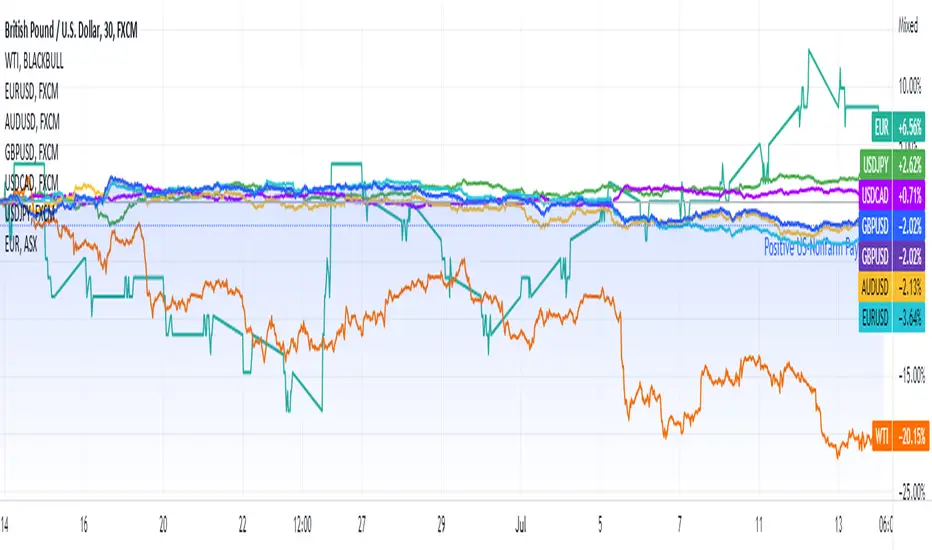EUR/USD 🔽
GBP/USD 🔽
AUD/USD 🔼
USD/CAD 🔼
XAU 🔽
WTI 🔼
Following the release of the US Consumer Price Index, which showed that prices rose by a significantly worse 9.1% YoY in June than anticipated (8.8%), the US dollar ended the day slightly weaker. The core figure came in at 5.9 percent, down the previous 6 percent but higher than the projected 5.8 percent, indicating that pricing pressures are still very much present.
The data first sparked risk aversion, causing stocks to plummet and government bond costs to skyrocket amid speculation that the US Federal Reserve may consider more significant rate hikes, raising the possibility of a recession.
Germany also released its CPI data, which showed that it was indeed 7.6 percent YoY as previously predicted.
Due to central bank imbalances, the EUR/USD pair is presently trading at about 1.0055 after reaching a peak of 1.0121. The US Federal Reserve has increased rates several times, and this month they will probably increase them by another 75 basis points. On the other hand, the European Central Bank will increase rates by 25 basis points to begin its gradual tightening in July.
Positive UK data helped the pound during European trading hours as the monthly GDP increased to 0.5 percent in May, a significant improvement from the previous -0.3 percent. Additionally, Manufacturing Production expanded by 2.3 percent YoY in the same month, above expectations, while Industrial Production increased by 1.4 percent YoY. The pair lost ground during the day, finishing at roughly 1.1890.
In July, the Bank of Canada increased its policy rate by 100 basis points to 2.5 percent, versus the market’s forecast for a rate increase of 75 basis points. The BOC recognized in its policy statement that, since the spring of last year, it has largely underestimated inflation due to external factors. Due to the dismal state of US equities, USD/CAD dropped to 1.2933 and is currently trading around 1.2980.
Prior to the announcement of Australian employment data, the AUD/USD pair maintained slight gains near 0.6760. The nation will release June employment data during the upcoming Asian session. After adding 60.6K new jobs in May, it is anticipated that the nation will have added just modestly 25K new jobs in June. The nation’s unemployment rate is also anticipated to decrease to 3.8 percent from 3.9 percent. Australia will also release July Consumer Inflation Expectations before the statistics, with analysts anticipating a decrease from the previous estimate of 6.7 percent to 5.9 percent.
While there was minimal movement in crude oil prices, WTI is currently trading at $95.80 per barrel. The gold price settled at $1,733 per troy ounce.
More information on Mitrade website.
GBP/USD 🔽
AUD/USD 🔼
USD/CAD 🔼
XAU 🔽
WTI 🔼
Following the release of the US Consumer Price Index, which showed that prices rose by a significantly worse 9.1% YoY in June than anticipated (8.8%), the US dollar ended the day slightly weaker. The core figure came in at 5.9 percent, down the previous 6 percent but higher than the projected 5.8 percent, indicating that pricing pressures are still very much present.
The data first sparked risk aversion, causing stocks to plummet and government bond costs to skyrocket amid speculation that the US Federal Reserve may consider more significant rate hikes, raising the possibility of a recession.
Germany also released its CPI data, which showed that it was indeed 7.6 percent YoY as previously predicted.
Due to central bank imbalances, the EUR/USD pair is presently trading at about 1.0055 after reaching a peak of 1.0121. The US Federal Reserve has increased rates several times, and this month they will probably increase them by another 75 basis points. On the other hand, the European Central Bank will increase rates by 25 basis points to begin its gradual tightening in July.
Positive UK data helped the pound during European trading hours as the monthly GDP increased to 0.5 percent in May, a significant improvement from the previous -0.3 percent. Additionally, Manufacturing Production expanded by 2.3 percent YoY in the same month, above expectations, while Industrial Production increased by 1.4 percent YoY. The pair lost ground during the day, finishing at roughly 1.1890.
In July, the Bank of Canada increased its policy rate by 100 basis points to 2.5 percent, versus the market’s forecast for a rate increase of 75 basis points. The BOC recognized in its policy statement that, since the spring of last year, it has largely underestimated inflation due to external factors. Due to the dismal state of US equities, USD/CAD dropped to 1.2933 and is currently trading around 1.2980.
Prior to the announcement of Australian employment data, the AUD/USD pair maintained slight gains near 0.6760. The nation will release June employment data during the upcoming Asian session. After adding 60.6K new jobs in May, it is anticipated that the nation will have added just modestly 25K new jobs in June. The nation’s unemployment rate is also anticipated to decrease to 3.8 percent from 3.9 percent. Australia will also release July Consumer Inflation Expectations before the statistics, with analysts anticipating a decrease from the previous estimate of 6.7 percent to 5.9 percent.
While there was minimal movement in crude oil prices, WTI is currently trading at $95.80 per barrel. The gold price settled at $1,733 per troy ounce.
More information on Mitrade website.
Disclaimer
The information and publications are not meant to be, and do not constitute, financial, investment, trading, or other types of advice or recommendations supplied or endorsed by TradingView. Read more in the Terms of Use.
Disclaimer
The information and publications are not meant to be, and do not constitute, financial, investment, trading, or other types of advice or recommendations supplied or endorsed by TradingView. Read more in the Terms of Use.
